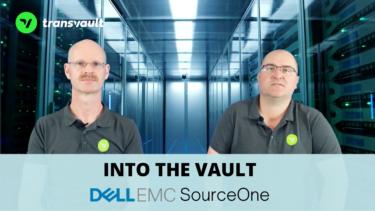
Transvault is the complete migration solution, especially for Dell EMC SourceOne.
The breadth of knowledge the support and development team possess is commendable for resolving issues where the SourceOne environment is affecting the migration outcome
EMC SourceOne End of Life
With SourceOne due to reach end of life in December 2024, it’s vitally important to take action and secure a trusted migration solution to protect your data. Without software maintenance, bug fixes and critical security patches from Dell, your SourceOne archive is vulnerable.
Now is the time to action a plan for retiring SourceOne and start planning your move to the cloud or another on-premises archiving solution. Transvault can help you reach the best possible outcome, making your migration seamless and ensuring the ongoing compliance of your data.
Find out more about SourceOne end-of-life planning.
Migrating from EMC SourceOne
Transvault’s SourceOne archive migrations utilise a state-of-the-art direct connector for SourceOne data extractions. This ensures you get unbeatable speed and optimum migration performance.
Our transactional transfers and full auditing of each and every item moved ensure full chain-of-custody for your data throughout the migration process.
Moving from EMC SourceOne to Microsoft Office 365
Transvault is the leading solution for SourceOne to Microsoft 365 migrations. Our Migrator software is the fastest, most efficient way to move the contents of your SourceOne archives directly into Microsoft’s cloud.
Our migrations utilise a direct connector from SourceOne into Microsoft Office 365. This slick, one-step migration ensures there are no interim stages or file formats that add time, complexity and risk to your move. Transvault offer migrations that minimise any impact on your network or legacy archive.
You can also move archived journals from EMC archives (including EMC Centera storage) into the Microsoft Office 365 compliance model. This enables you to use Microsoft 365 as a one-stop-shop for retention management and eDiscovery.
We also support EMC SourceOne migrations to other platforms:
Start your EMC migration today
Transvault – Refreshingly Simple Migrations
With over a decade of experience with EMC migrations, Transvault is the premium solution for your organisation. We’re passionate about solving complex challenges, with world-class technology and integrity. With SourceOne migrations, we’re 100% focused on achieving the outcome your business needs, going above-and-beyond to make your move a success. We prioritise compliance and data integrity, delivering a full-chain-of-custody.
Get in contact today or get a quote.
SourceOne Migration FAQs
- Why use Transvault for our EMC to Exchange Migration?
-
Transvault delivers rapid and comprehensive migrations from EMC’s EmailXtender and EMC SourceOne back into Microsoft Exchange, Microsoft Office 365 and other archive platforms such as Enterprise Vault.
- One Step – Migration is done at the API level in a single, synchronous step, requiring no interim stage or interim storage.
- Transparent to users – Users can access their data whilst it is being moved – there is no need to disable access to the archive. Shortcuts are seamlessly converted to point to the new archive store, ensuring the upgrade process is completely transparent to end users.
- Ensures Compliance – Throughout the migration process Transvault maintains a full audit trail to maintain chain-of-custody – this is an important consideration for compliant retention.
- Automatic Failover & Logging – Transvault keeps a complete error log, with the ability to automatically resume a migration task that fails for any reason (e.g. owing to a network outage or a corrupted item).
- Notes to Exchange Conversion – If you’ve been using EmailXtender or SourceOne for Notes, and you want to migrate to Exchange, Transvault delivers on-the-fly, high fidelity Notes to Exchange conversion.
- Advanced Features – Transvault enables high flexibility, including the ability to perform email address re-writes to address the needs of a company restructuring, etc.
- Does Transvault Support Extractions from EMC Storage?
-
Yes. Transvault supports migration of archives that have been written to EMC DiskXtender, as well as a variety of media types, including EMC Centera devices, DVD-R, tape, or magneto-optical Ultra-Density Optical (UDO), WORM, WORM-tape, and Network Attached Storage (NAS).
- What happens to shortcuts (stubs) when we migrate to Microsoft Office 365?
-
Transvault provides a comprehensive shortcut management service that ensures users have a seamless experience when they migrate.
When moving to Microsoft Exchange (or Microsoft Office 365), legacy shortcuts are replaced (rehydrated) with the original item. You can also set policies that determine whether items are moved into Primary mailboxes or In-place Archives. For example, you could move items older than 2 years into archives, and keep everything ‘younger’ in the Primary mailbox.
Another key feature designed to ensure a great user experience is that Transvault synchronises with the current status of users’ shortcuts as they exist in their mailbox at the time of the migration.
For example, where users have re-foldered their shortcuts ‘post-archiving’, Transvault ensures the corresponding items end up in the right folders post-migration.
Similarly, where users have deleted their shortcuts, you can configure Transvault not to migrate the corresponding item, as this is confusing and causes concern for end users when deleted items reappear.
- How quickly can we move our archives from EMC to Exchange?
-
Transvault offers the fastest and safest migration times in the industry. This is confirmed by the many Partners we have that have direct, project-based experience of Transvault vs other migration solutions.
Transvault’s multi-threaded, multi-server capability means that multiple extraction and ingestion pipes can be set up between your source and target system, thus driving your environment to capacity. You can also process a single mailbox using multiple migration threads – ideal for processing large archives and journals in the fastest possible times.
It is important to note that achieving best performance is always dependent on environmental factors such as:
- Available network bandwidth
- Speed of the storage subsystem on which the legacy archive sits as well as the destination storage
- The ingestion performance of the target archive system
- The scheduling of other project elements such the commissioning of the target environment.
